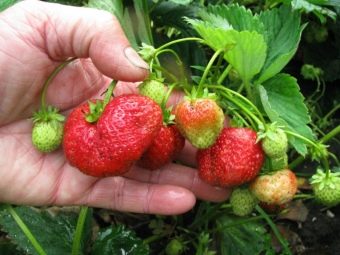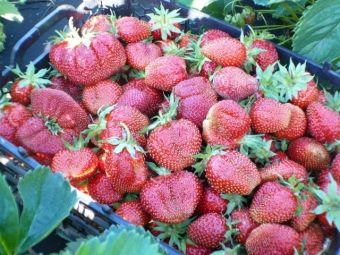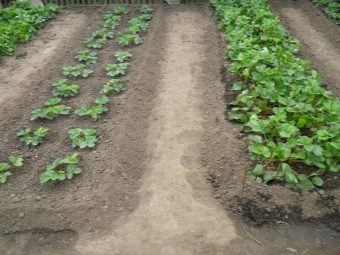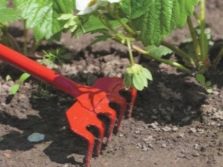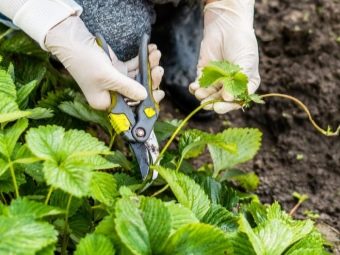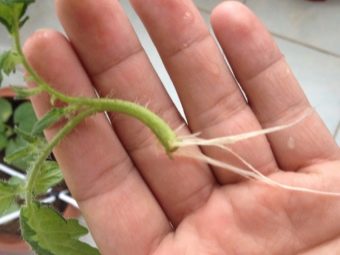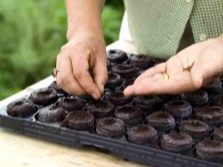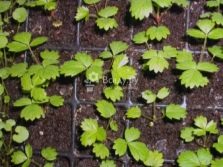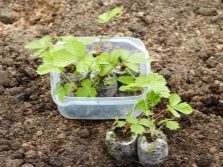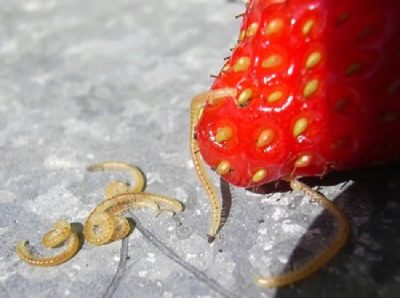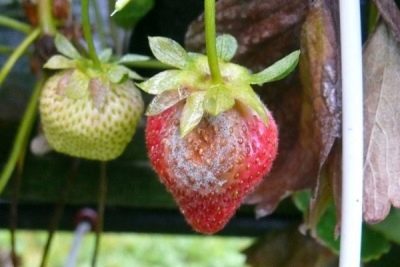Strawberry "Masha": characteristics and characteristics of growing
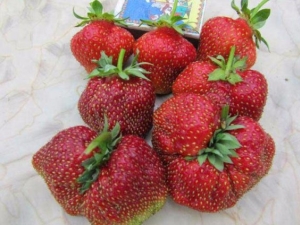
Variety description
Strawberry "Masha" - our, domestic variety. Appeared in 1953 by crossing the varieties "Komsomolskaya Pravda" and "Beauty Zagorye".Berry has become popular with the population in a short time.
This type of strawberry is easy to grow. It grows in a greenhouse or in open beds. At home - on the windowsill, balcony - the berry will not grow.
“Masha” is remarkable because in warm regions the harvest can be harvested twice during the summer. Fruitfulness is high. At the first harvest they pick berries weighing up to one hundred grams. With repeated - the weight of about forty grams.
Large fruits grow due to the fact that the first flowers grow thickly and when the ovary berries grow together. The strawberry pulp is dense, sweet. Void inside come across rarely. The aroma is strong. The color of ripe strawberries is dark red, closer to burgundy. The shape of the fruit slightly flattened with grooves. Bushes are small, but thick, large leaves grow up. Due to the size of the bushes, on one bed you can grow more strawberries than usual and harvest more.
Dislikes "Masha" direct sunlight, from this she appears dark spots on the leaves and berries. Poor tolerance and cooling. Ripens early, in the first half of June, you can already collect.
Easy to transport and store. Due to the dense pulp the berry does not flow.
It is intended both for the fresh use, and for preparation of preparations.
Landing
First of all, you need to decide on a landing site. The site should be flat, a small slope is possible. In the lowland can not be planted, the depth of groundwater should be at least seventy centimeters. Direct sunlight is undesirable, the beds should cover the partial shade.
Strawberries are planted no earlier than mid-May, and two weeks before they begin to prepare the soil. The soil is desirable loose, saturated with air. If necessary, add sand to it. The beds before planting dig up, get rid of bugs and roots.
Make fertilizer in moderation. A large number of nutrients will lead to rapid growth of leaves and reduce the harvest. Fertilize soil with organic matter - it can be manure or humus, and nitrogenous fertilizers.
In the second half of May, our bushes are ready for planting. In the beds dig up grooves, make holes. The depth of the holes is about fifteen, twenty centimeters. The distance is forty cm.
On one bed it is better to do two grooves and the distance between the rows is the same. Warm water is poured into each hole and seedlings are placed. Then sprinkle with earth. The growth point (core) must remain on the surface. Next, the soil is covered with mulch.
If frosts are expected, the bushes will hide for the night under the covering material. Purchased seedlings incubated before planting in a dark place a couple of days. Bushes, grown independently of seeds, are planted immediately. For planting choose cool, cloudy day.
Care
Care for "Masha" easy. Two weeks after planting, inspect the plants. Those who have not taken root are removed, new ones are planted in their place.
Garden strawberry likes abundant, but infrequent watering. Water, depending on the weather, once a week, with warm water at the root, in the morning. It is better to use the drip system or channels. When rainy wet weather, strawberries are covered to avoid excess moisture.
After watering the soil loosened. This should be done carefully, as the roots of the strawberries are located close to the surface. If the roots protrude from the ground, they are simply sprinkled. When a weed appears, it is carefully removed.
In the first year, the berry is fertilized only in spring. Starting from the second year, fertilizers are applied at the beginning of fruiting and after harvesting. During the formation of the fruit bushes need to feed a mixture of potassium sulfate and ammonium nitrate. In the fall it is customary to make organic and mineral fertilizers.
Mulch on the bed should be constantly. Ripening berries fall on the ground, and mulching will help avoid rotting fruit. Suitable for this purpose:
- needles;
- dry moss;
- hay;
- sawdust.
Mustache in fruiting bushes pruned.Releasing whiskers, strawberries spend on them strength and nutrients, and accordingly, the yield is reduced.
Gather berries in two or three days after they turn red. Cut or tear them together with the stalk. This increases the shelf life of the fruit and provides better transportation.
In the fall, dry leaves are pruned, leaving only normal, healthy leaves.
Breeding
Propagated "Masha" in two ways - a mustache and seeds.
Usa
A good time to grow new bushes with a mustache is the second half of May or in the summer, the last week of July and the first of August. In the summer, planting a mustache is preferable, since at this time strawberries give a large number of them; before the frosts start, new bushes will have time to take root and gain strength. This will help them survive the winter with minimal losses.
For breeding choose strong, healthy plants with good fruits. The whiskers on them should be smaller than the berries. Choose the strongest mustache. The first outlet on it is slightly twisted to stimulate the growth of the root system. Lightly press the socket to the ground, the rest is cut. All other mustache from the bush should be cut. After about two weeks, the outlet will have roots. A week before transplanting seedlings to a new place, separate the mustache with the socket from the bush. After a week, you can transplant seedlings to a new place.
Seeds
There are two ways to get the seed yourself.
- From the ripe berries gently cut off the top layer with the seeds. Spread on paper in a shaded, well-ventilated place. After two, three days the dried flesh is gently rubbed with fingers, separating the seeds.
- Put the berries in the water, lightly whisk with a blender. Next, the resulting mass is filtered through a fine strainer. The seeds remaining in it are dried, as in the first case.
Planting begin in January-February, if you plan to get a harvest in the same year. When planting seeds in May-June, fruiting will begin only next year.
Prepare a soil mixture. Two parts of the land take one part peat and one sand. The latter can be replaced with vermiculite. Sometimes for disinfection the ground is watered with a pale pink solution of potassium permanganate.
Gently tweezers spread the seeds in containers and watered. Sprinkle seeds on top of the ground is not necessary. Cover planting film and maintain a temperature not lower than eighteen degrees.
With the advent of the first true leaves, strawberries require good illumination. It is desirable that the light hit the plants at least eight hours a day. At the same time, seedlings begin to harden, briefly lifting the film. Each time the ventilation period is increased.
With the appearance of three or four true leaves of the plant dive using the method of handling. Picks can be avoided by initially planting each seed in a separate container.
Seedlings are planted in the open ground not earlier than the fifth true leaf appears.
Feed young plants can be fertilizers containing phosphorus, nitrogen and potassium.
Diseases and pests
This variety of garden strawberry is small, but still subject to disease.
First of all, from them and pests helps prevention. Preventive measures include:
- crop rotation Place of landing change every four years. Do not plant the berry after cucumbers and solanaceous crops. Carrots, rye, oats, parsley will be good forerunners;
- moisture control. Too much watering can damage the plant;
- cleaning of weeds from beds;
- spraying karbofos at the end of the fruiting period;
- removal of dried leaves from bushes.
The main danger for this variety are:
- Strawberry Mite. The bushes stop growing, the berries dry yet unripe, a silver film forms on the back of the leaf, the young leaves become dry and wrinkled. Chemical preparations, plants planted nearby (tansy, catnip), folk remedies (spraying a decoction of onion peel) will help the tick cope.
- Strawberry nematode. The plant ceases to grow, the leaves gradually become pale, turn yellow and, as a result, turn black. Fruits are deformed at the stage of the ovary. To combat the plant is washed with hot water, after digging it. Her temperature should be fifty, fifty-five degrees. Spray the bushes infusion of onion peel and apply chemicals.
- Mealy dew. The plant is covered with a white mealy bloom. Flowers dry up, not having time to give the ovary, ripe fruit moldy. From this disease in addition to industrial preparations helps mulching and soil moisture control.
Gardeners reviews
According to experienced gardeners, strawberry "Masha" is easy to grow and care, gives an excellent harvest. Berry is fragrant, large. Good for fresh use. Jam, jams and compotes from it are distinguished by a bright taste and a pleasant smell.
According to responses of summer residents who have no opportunity to spend all summer in a kitchen garden, strawberry does not demand special attention to itself. And coming to the country once a week, you can not worry about the lack of harvest. Until the end of August, gardeners pick berries, not spending all their free time on caring for the beds.
About what characteristics of strawberries varieties "Masha", see the following video.

